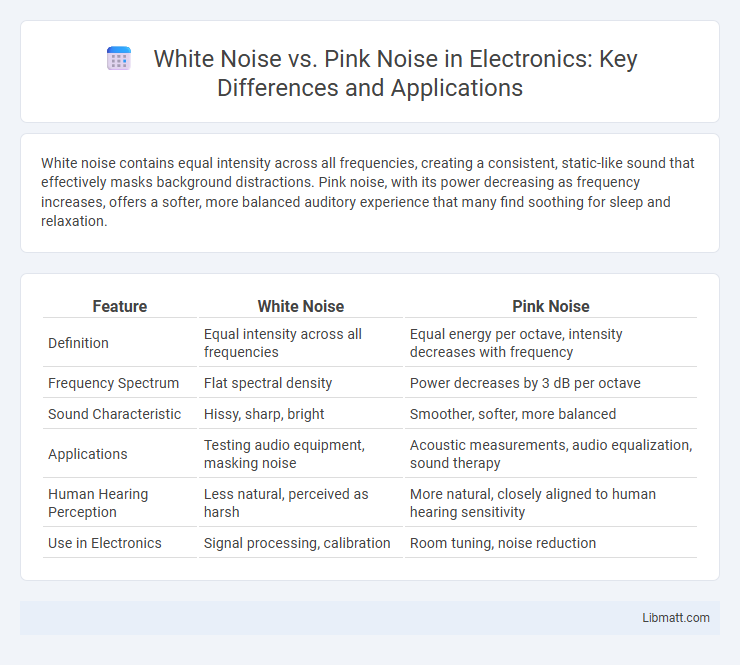White noise contains equal intensity across all frequencies, creating a consistent, static-like sound that effectively masks background distractions. Pink noise, with its power decreasing as frequency increases, offers a softer, more balanced auditory experience that many find soothing for sleep and relaxation.
Table of Comparison
| Feature | White Noise | Pink Noise |
|---|---|---|
| Definition | Equal intensity across all frequencies | Equal energy per octave, intensity decreases with frequency |
| Frequency Spectrum | Flat spectral density | Power decreases by 3 dB per octave |
| Sound Characteristic | Hissy, sharp, bright | Smoother, softer, more balanced |
| Applications | Testing audio equipment, masking noise | Acoustic measurements, audio equalization, sound therapy |
| Human Hearing Perception | Less natural, perceived as harsh | More natural, closely aligned to human hearing sensitivity |
| Use in Electronics | Signal processing, calibration | Room tuning, noise reduction |
Understanding White Noise: Definition and Characteristics
White Noise is a type of sound signal that contains equal intensity across all frequencies within the audible range, creating a consistent, static-like sound similar to a TV tuned to an unused channel. It is characterized by its flat spectral density, producing a harsh and sharp auditory experience that masks other noises effectively. Your understanding of White Noise helps in applications such as sound masking, sleep improvement, and concentration enhancement by providing a steady background sound.
Exploring Pink Noise: What Sets It Apart?
Pink noise differs from white noise by distributing equal energy per octave, resulting in a balanced sound spectrum that is perceived as softer and more natural. This frequency weighting reduces the emphasis on higher frequencies, making pink noise ideal for sound masking, sleep improvement, and audio testing. Its unique acoustic properties support relaxation and focus, distinguishing it from the harsher, more uniform frequency distribution of white noise.
The Science Behind Noise Colors
White noise contains all frequencies at equal intensity, producing a consistent sound spectrum that masks background noise effectively. Pink noise distributes energy equally per octave, resulting in a balanced sound with reduced high-frequency intensity, making it more soothing for human perception. These spectral differences influence their applications in sound therapy, sleep aids, and audio testing.
Sound Frequencies: How White and Pink Noise Differ
White noise contains equal intensity across all sound frequencies, creating a consistent hiss that covers the entire audible spectrum uniformly. Pink noise decreases in intensity by 3 decibels per octave, resulting in more energy in lower frequencies and a deeper, softer sound compared to white noise. This frequency distribution in pink noise aligns more closely with human hearing sensitivity, making it ideal for sound masking and sleep aid applications.
Applications of White Noise in Daily Life
White noise is widely used in daily life to improve sleep quality by masking background sounds, creating a consistent auditory environment conducive to relaxation. It helps increase concentration and productivity by reducing distractions in office spaces and study areas. You can also find white noise in baby monitors and tinnitus relief devices, providing soothing soundscapes that promote comfort and calm.
Benefits of Pink Noise for Sleep and Relaxation
Pink noise, characterized by equal energy per octave, promotes deeper and more restful sleep by enhancing slow-wave brain activity, which is crucial for memory consolidation and physical recovery. It reduces sleep fragmentation and increases overall sleep efficiency, making it beneficial for individuals with insomnia or disrupted sleep patterns. Compared to white noise, pink noise creates a more soothing and less harsh auditory environment, ideal for relaxation and stress reduction.
White Noise vs Pink Noise: Which Is Better for Focus?
White noise contains all frequencies at equal intensity, creating a consistent sound that masks distractions, while pink noise emphasizes lower frequencies, producing a softer, more natural ambiance that can enhance relaxation. For focus, your choice depends on personal preference and the environment; white noise is often better for blocking sudden sharp sounds, whereas pink noise may improve concentration by being less harsh on the ears. Experimenting with both can help determine which noise optimizes your productivity and minimizes distractions effectively.
Using Noise Machines: Tips for Optimal Results
When using noise machines for sleep or focus, choosing between white noise and pink noise depends on your auditory preference and environment; white noise provides a consistent, static-like sound that masks sudden noise disruptions, while pink noise offers a softer, deeper frequency spectrum that may feel more natural and soothing. Position your noise machine at a moderate volume, enough to mask ambient sounds without disturbing your relaxation or concentration. Regularly cleaning the device and using timers can enhance your experience, ensuring your sleep or focus routine remains uninterrupted and effective.
Common Misconceptions About White and Pink Noise
White noise is often mistaken as universally soothing, but its constant high-frequency content can be harsh and overwhelming, unlike pink noise which balances frequencies to mimic natural sounds. Many believe pink noise is just a softer form of white noise, yet its energy distribution is designed to reduce auditory fatigue and promote relaxation more effectively. Understanding these differences helps you choose the right sound environment for better sleep or focus.
Choosing the Right Noise for Your Needs
White noise produces a consistent sound that covers all frequencies equally, making it ideal for masking environmental distractions and promoting focused concentration. Pink noise emphasizes lower frequencies with equal energy per octave, providing a soothing, natural ambiance that can improve sleep quality and relaxation. Understanding your needs for either increasing alertness or enhancing sleep will guide you in selecting the noise type best suited for your environment and personal preferences.
White Noise vs Pink Noise Infographic

 libmatt.com
libmatt.com